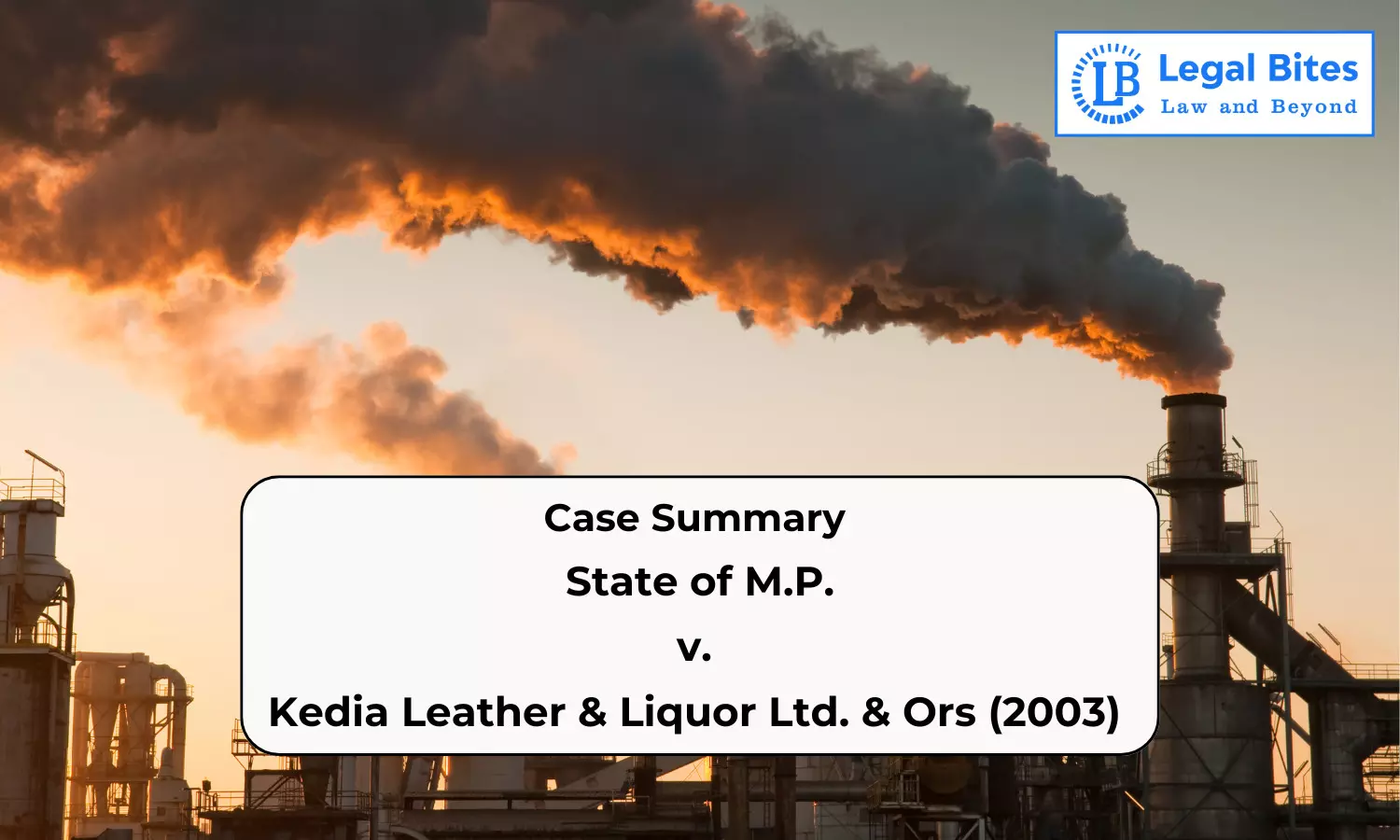Case Summary: State of M.P. v. Kedia Leather & Liquor Ltd. & Ors (2003) | Industrial Pollution and Environmental Laws
The Supreme Court of India ruled in favour of stronger environmental regulation and emphasized the need for industries to comply with environmental laws.

The decision in State of M.P. v. Kedia Leather & Liquor Ltd. & Ors. serves as a precedent for cases involving environmental degradation caused by industrial activities, emphasizing the duty of both the government and industries to prevent pollution.Case Title: State of M.P. v. Kedia Leather & Liquor Ltd. & OrsCourt: Supreme Court of India Bench: Doraiswamy Raju and Arijit Pasayat, JJ.Date of Judgment: August 19, 2003Factual BackgroundThe case emerged from a dispute...
The decision in State of M.P. v. Kedia Leather & Liquor Ltd. & Ors. serves as a precedent for cases involving environmental degradation caused by industrial activities, emphasizing the duty of both the government and industries to prevent pollution.
Case Title: State of M.P. v. Kedia Leather & Liquor Ltd. & Ors
Court: Supreme Court of India
Bench: Doraiswamy Raju and Arijit Pasayat, JJ.
Date of Judgment: August 19, 2003
Factual Background
The case emerged from a dispute concerning pollution caused by industries in Madhya Pradesh. The Sub-Divisional Magistrate (SDM) initiated proceedings under Section 133 of the CrPC, directing certain industrial units, including Kedia Leather and Liquor Ltd., to cease operations due to the pollution they were causing. The industries appealed against this order, arguing that the enactment of the Water (Prevention and Control of Pollution) Act, 1974, and the Air (Prevention and Control of Pollution) Act, 1981 impliedly repealed Section 133 of CrPC, making it inapplicable to matters of environmental pollution.
The Madhya Pradesh High Court ruled in favour of the industries, holding that the Water Act and Air Act had impliedly repealed Section 133 CrPC in cases of environmental pollution. Aggrieved by this decision, the State of Madhya Pradesh appealed to the Supreme Court.
Issues
- Whether the enactment of the Water Act and Air Act impliedly repealed Section 133 CrPC, which deals with public nuisance.
- Whether Section 133 CrPC can co-exist with the provisions of the Water Act and Air Act, or if these laws are mutually exclusive.
Laws Applied:
Section 133 CrPC: This section empowers a magistrate to remove public nuisances affecting public health, safety, and convenience. It is preventive in nature and provides immediate relief from nuisances.
Water (Prevention and Control of Pollution) Act, 1974: This Act regulates water pollution and sets standards for water quality, providing the State Pollution Control Boards (SPCBs) with the power to enforce these standards.
Air (Prevention and Control of Pollution) Act, 1981: Similar to the Water Act, the Air Act deals with air pollution and grants authority to SPCBs to ensure compliance with air quality standards.
High Court’s Decision:
The Madhya Pradesh High Court held that the Water and Air Acts were special statutes designed to address specific environmental concerns and that these laws had effectively overridden Section 133 of the CrPC. The court found that allowing both the CrPC and the environmental statutes to coexist would create unnecessary legal complications and confusion. It thus ruled that the SDM had no jurisdiction to use Section 133 for pollution-related issues, as these were now covered by the Water and Air Acts.
Supreme Court’s Judgment:
The Supreme Court, after examining the provisions of both the CrPC and the pollution control laws, overturned the High Court’s decision. The key points of the judgment were as follows:
I) Distinct Purposes and Areas of Operation:
The Court held that Section 133 of the CrPC and the Water and Air Acts operate in different fields. Section 133 is designed to prevent public nuisances with a sense of urgency, while the Water and Air Acts have a broader scope, aiming to prevent and control environmental pollution. The court noted that the objectives of the CrPC provisions and the pollution control laws, though related, are not identical.
II) Doctrine of Implied Repeal:
The doctrine of implied repeal states that when a new law is passed, it repeals any previous law on the same subject if the two cannot coexist. However, the Court ruled that there was no implied repeal in this case because the CrPC and the environmental laws could coexist. The court emphasized that there is a presumption against implied repeal unless there is a direct conflict between the two laws, and in this case, no such conflict existed.
III) Preventive v. Penal Nature of Laws:
The Court highlighted that Section 133 of the CrPC is preventive, and intended to provide immediate relief in situations of public nuisance, while the Water and Air Acts are both preventive and penal, dealing with broader pollution control measures. Since the laws serve different purposes, they can function alongside each other without causing legal inconsistencies.
IV) Nuisance under Section 133 CrPC:
The Court clarified that nuisance under Section 133 refers to conditions that cause danger or inconvenience to public health or safety. In this case, pollution caused by the industries was clearly a public nuisance, and the SDM had the authority to act under Section 133 to prevent further harm. The Court stated that the immediate nature of the SDM’s order was justified, given the urgency of preventing irreparable damage to the public.
V) Coexistence of Laws:
The Court concluded that both the CrPC and the environmental laws could coexist without one superseding the other. The provisions of Section 133 were not impliedly repealed by the Water and Air Acts. The Court further emphasized that the legislature, while enacting the Water and Air Acts, was aware of the existence of Section 133 CrPC and did not expressly repeal it. Therefore, the presumption against implied repeal stood firm.
Conclusion
The Supreme Court held that there was no implied repeal of Section 133 of CrPC by the Water and Air Acts. The provisions of the CrPC and the pollution control laws serve different purposes and operate in separate fields. Thus, the High Court’s judgment was partly reversed. The SDM was within its rights to issue orders under Section 133 CrPC to address public nuisances caused by pollution, and the pollution control mechanisms under the Water and Air Acts could operate independently.
The appeals were allowed in part, and the Supreme Court directed the appropriate forums to address specific issues of pollution in line with both sets of laws. The matter regarding potential infractions under Section 133 CrPC and the pollution control laws was left to be dealt with by the relevant authorities.
Significance of the Case
This judgment clarifies the scope and applicability of public nuisance provisions under Section 133 CrPC in environmental law. It highlights that the Water Act and Air Act do not replace or override the broader provisions of CrPC regarding public nuisances. This ruling ensures that general and special statutes can operate together, with each serving its intended purpose without unnecessary conflicts.
Click Here to Read the Full Judgment

Apurva Neel
I am a Research Associate and Editor at Legal Bites with an LL.M. specialization in Corporate and Commercial Laws from Amity University, Mumbai. I have put my best efforts into presenting socio-legal aspects of society through various seminars, conferences etc. I keep refining content as I am an ardent writer, and palpably law has got multi-dimensional aspect, so I passionately try to explore ahead.
